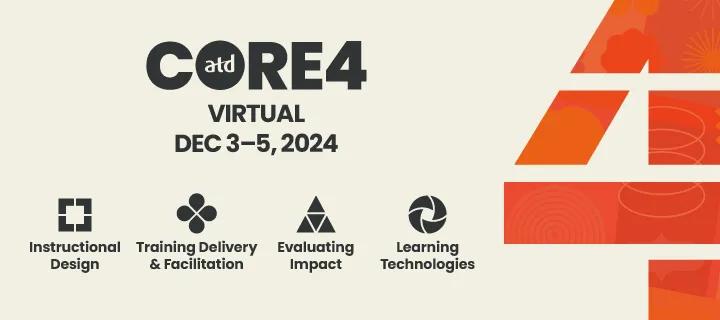ATD Blog
Digging Deeper: How Root Cause Analysis Transforms Training
Embracing RCA strengthens our training initiatives and positions us as strategic partners in solving organizational challenges.
Wed Jul 24 2024

As training professionals, we are recognized for our ability to competently create learning experiences that equip others with the skills and abilities necessary to do their job. People come to us as learning experts because we know how to engage adult learners and create innovative learning opportunities.
But, when was the last time you explored why you’re training? If it’s been a while, don’t worry—you’re probably like many training professionals. We’ve often been conditioned to accept the task at hand. If we’re fortunate, we’ve had the time and resources to conduct thorough needs analyses and identify skills gaps.
Getting to the Root of the Issue
If you have experience with process improvement or change management, you’re likely familiar with Root Cause Analysis (RCA). RCA is a process designed to uncover the underlying reasons why something occurred. For example, let’s say there’s a noticeable decline in customer satisfaction scores. An initial response might be to train customer service representatives on better communication skills. However, without a proper RCA, you might miss other underlying issues such as outdated systems causing delays, unclear company policies, or even lack of adequate staff support.
By conducting an RCA, you dig deeper to identify not just the symptom (poor customer satisfaction scores) but the root cause (outdated systems, unclear policies, insufficient staff support). This deeper understanding allows you to design training that addresses the real issues rather than just applying a superficial fix.
The Need for RCA in Training
RCA is essential in training because it ensures that the solutions address the actual problems rather than just their symptoms. By identifying the underlying causes of performance issues, training professionals can design more effective and targeted interventions. This leads to improved outcomes, better resource allocation, and higher satisfaction among stakeholders. RCA also helps prevent recurring issues, fostering a proactive approach to problem-solving in organizational training.
Steps to Conduct an RCA
Let’s continue with our customer service example. Imagine you’ve been tasked with designing a communication training to address gaps in customer service skills. Rather than diving straight into a needs analysis or simply agreeing to the task, take a beat and make time to guide your stakeholders through an RCA.
As a training professional, your role in this process is part investigator, part facilitator. You won’t have all the necessary information on your own, so you’ll need to collaborate with those who do. The steps below outline how to effectively conduct an RCA as a training professional:
Define the Problem
The first step is to get your stakeholders to agree on the problem. Start by asking them what issues they are observing. If the process is observable (for example, customer service agents not following the protocol to route customers correctly), it's beneficial for you to observe it yourself. This firsthand observation helps you understand why the issue is happening. Often, stakeholders have different perspectives on what the problem actually is, which is where our next step comes in.
Gather and Analyze Data
It’s not enough to rely solely on stakeholders’ input about the problem. While their insights are valuable, diverse perspectives can lead to varying views on the issue. This diversity is beneficial for decision making but requires grounding in quantifiable evidence. Collect data related to the problem through surveys, performance metrics, interviews, and observations. Think of this step as gathering clues to build a comprehensive case—this is where you’ll get your first big break in understanding the issue. Gathering accurate and comprehensive data can be a challenge. One best practice is to use multiple data collection methods, such as surveys, interviews, and observations, to triangulate information.
Identify Possible Causes
This is where your investigation gains momentum! Determining the actual root cause of an issue can be challenging, especially if the problem is complex and multifaceted. Use structured tools like the “5 Whys” and Fishbone Diagrams to systematically explore potential causes. Engage subject matter experts to provide insights and verify the identified root causes.
For example, in the case of low customer satisfaction scores, begin by asking why the group believes these scores are low. It may sound something like this:
Why are our customer satisfaction scores low? Because customers are experiencing long wait times.
Why are customers experiencing long wait times? Because our customer service representatives are handling a high volume of calls.
Why are representatives handling a high volume of calls? Because there are frequent issues with our product that customers need help with.
Why are there frequent issues with our product? Because recent changes to the product were not adequately tested.
Why were the changes not adequately tested? Because we were under a tight deadline to release the new features.
In this example, the issue isn’t a skill gap but rather product issues that need addressing. As a learning professional, you have helped identify the root cause, enabling a suitable solution to be implemented. Let’s now consider another scenario where learning is the solution:
Why are our customer satisfaction scores low? Because customers are experiencing long wait times.
Why are customers experiencing long wait times? Because our customer service representatives are taking longer to resolve issues.
Why are representatives taking longer to resolve issues? Because they are not equipped to handle a common issue related to the recent feature upgrade.
Why are representatives not equipped to handle issues with the new billing system? Because they have not received adequate training on troubleshooting and resolving problems specific to the new billing system.
Why have they not received adequate training on the new billing system? Because the training program was not updated in time to cover the new billing system features and troubleshooting procedures.
In this case, there is a skill gap. Customer service representatives need training to handle the new billing system issues effectively. Thus, training will be a key component of the solution.
Develop Solutions
Based on your findings, develop targeted solutions that address the root cause. This might involve changes in processes, policies, or training programs. If training is the answer, ensure your approach targets the exact skills needed to close the performance gap.
If education is not part of the solution, it’s up to other teams to implement the solution. However, this doesn’t mean that learning and development professionals can’t support the process. They can lend their expertise as part of a stakeholder group, providing insights and guidance to ensure the solution is comprehensive and effective. If a solution requires significant adjustments to current processes, stakeholders may be resistant to those changes. Therefore, involve stakeholders early in the process to build buy-in and ownership. Clearly communicate the benefits of the proposed changes and provide support during the transition period.
Conducting a thorough RCA and implementing solutions can be resource-intensive, requiring time, personnel, and financial investment. You can prioritize RCA efforts on high-impact issues where the benefits outweigh the costs. Leverage existing resources and seek support from leadership to allocate necessary resources for critical initiatives.
By understanding and addressing these challenges with best practices, training professionals can conduct more effective RCAs, leading to better-targeted interventions and sustainable improvements.
Implement and Monitor
Put your solutions into action and monitor their effectiveness. Be prepared to make adjustments as needed. Continuously monitor the solution once implemented and remain agile, iterating on the solution based on feedback and results.
Conclusion
RCA is a powerful tool for training professionals, enabling us to move beyond surface-level solutions and address the underlying issues that impact performance. By thoroughly understanding and addressing the root causes of problems, we can design more effective training programs, enhance stakeholder satisfaction, and contribute to the overall success of our organizations. Embracing RCA not only strengthens our training initiatives but also positions us as strategic partners in solving organizational challenges.
You've Reached ATD Member-only Content
Become an ATD member to continue
Already a member?Sign In

